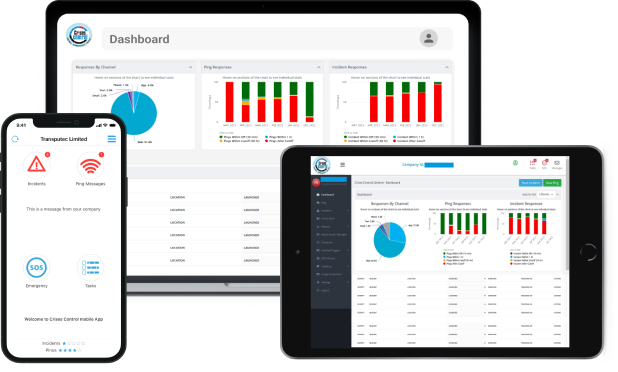Written by Anneri Fourie | Crises Control Executive
Small and medium-sized enterprises (SMEs) often assume that major disruptions only impact large corporations. But the truth is, SMEs are just as vulnerable, if not more so, because they typically lack the resources to recover quickly from unexpected crises. Whether it’s a cyberattack, extreme weather, IT failure, or supply chain disruption, a single incident can bring operations to a halt, leading to financial losses, regulatory penalties, and even business closure.
A well-structured Business Continuity Planning Software is no longer optional, it’s essential. Without it, an unexpected crisis can cause irreparable damage. But with the right technology in place, SMEs can minimise disruption, maintain communication, and recover quickly.
In this blog, we’ll explore the risks of operating without a business continuity plan, how technology helps businesses stay resilient, and how Crises Control provides SMEs with a comprehensive solution for crisis management and rapid recovery.
The Risks of Operating Without Business Continuity Planning Software
Many SMEs don’t prepare for crises because they assume that disruptions won’t happen to them. Unfortunately, this mindset leads to gaps in preparedness, making it harder to respond effectively when something does go wrong. Here are some of the biggest risks that businesses face without a solid continuity strategy.
1. Downtime Can Be More Costly Than You Think
Unexpected events like IT failures, cyberattacks, or extreme weather can stop business operations in an instant. And when that happens, the cost can be staggering.
According to Pingdom, small businesses experience downtime costs of approximately $427 per minute, while larger businesses face costs closer to $9,000 per minute. In manufacturing, downtime can be particularly costly, averaging around $260,000 per hour. Additionally, a 2024 study by Encomputers highlighted that a company generating $10 million in revenue could incur up to $55,000 in daily downtime costs, excluding recovery expenses and potential reputation damage.
Beyond the immediate financial impact, there’s also lost productivity, missed deadlines, and dissatisfied customers, all of which can have lasting consequences.
2. Non-Compliance Can Lead to Legal and Financial Penalties
Many industries require businesses to have continuity and incident response plans in place to comply with regulations. Failure to meet these requirements can lead to legal penalties, hefty fines, and damage to business credibility.
For example, in sectors such as finance, healthcare, and manufacturing, regulators expect businesses to have documented and regularly tested continuity plans. Without one, an SME could face lawsuits, loss of contracts, or even forced closure.
3. Poor Communication Makes Crises Worse
A lack of structured communication during a crisis can create unnecessary confusion and delays. Employees might not know what steps to take, customers might be left in the dark, and misinformation could spread quickly.
Without Mass Notification Software, businesses struggle to send clear, timely updates to the right people, leading to slow response times and increased damage.
4. Reputational Damage Can Be Irreversible
Customers and stakeholders expect businesses to be reliable, even during disruptions. If a business fails to respond effectively to a crisis, trust erodes quickly.
While specific statistics on customer attrition due to crises vary, research indicates that poor crisis management significantly impacts customer retention. For example, a 2016 Accenture study found that 52% of consumers switched providers in the past year due to poor customer service, with banks, retailers, and cable providers being the most affected. Additionally, a 2020 Statista survey revealed that a notable percentage of U.S. customers ceased doing business with companies because of subpar customer service experiences.
These findings underscore the importance of effective crisis management and robust business continuity planning. Without such strategies, businesses risk not only immediate operational disruptions, but also long-term customer attrition, reputational harm, and diminished market position.
How Business Continuity Planning Software Helps SMEs Stay Resilient
A Business Continuity Planning Software provides an organised, technology-driven approach to crisis management. Instead of scrambling to respond to a disruption, businesses have a clear, structured plan in place, ensuring a fast and effective response. Here’s how it makes a difference:
1. Automated Incident Management for Rapid Response
A crisis can escalate quickly, and without a structured response plan, small delays can lead to big problems. Incident Management Software automates the process, ensuring that the right people are alerted immediately and that response teams can take action without confusion or delay.
How Crises Control Helps:
- Real-time incident tracking allows businesses to monitor disruptions as they happen.
- Automated escalation procedures ensure that critical incidents are addressed without delay.
- Post-incident reports help businesses analyse what went wrong and improve future responses.
2. Mass Notification Software for Fast, Reliable Communication
Timely communication is crucial during a crisis. Whether it’s informing employees about an IT failure or updating customers about a service disruption, businesses need a Mass Notification Software to send instant alerts across multiple channels.
How Crises Control Helps:
- Multi-channel alerts (SMS, email, push notifications, voice calls) ensure no one misses a critical message.
- Read receipts and confirmation tracking help businesses monitor who has received and acknowledged messages.
- Targeted messaging enables businesses to send updates to specific teams or departments.
3. Cloud-Based Accessibility for Uninterrupted Operations
One of the biggest challenges during a crisis is accessing critical business information when it’s needed most. A cloud-based Business Continuity Planning Software ensures that continuity plans, incident reports, and emergency procedures are always available.
How Crises Control Helps:
- Secure cloud storage keeps business continuity plans accessible from anywhere.
- Remote access capabilities allow crisis management teams to respond even if they’re off-site.
- Real-time updates ensure that all stakeholders have the most current information.
- Crises Control stays operational even if other systems are down.
4. Task Management to Keep Response Teams Organised
In a crisis, businesses need to assign and track tasks in a structured way to ensure nothing is overlooked. Task management tools ensure that every critical action, from IT recovery to customer communication, is handled efficiently.
How Crises Control Helps:
- Task tracking and assignment ensures that every action is accounted for.
- Automated reminders prevent delays in crisis response.
- Integration with incident management enables seamless execution of business continuity plans.
5. Data Security and Compliance Management
Cybersecurity threats are one of the biggest risks SMEs face today. A Business Continuity Planning Software helps businesses safeguard their data while maintaining compliance with industry regulations.
How Crises Control Helps:
- Encrypted cloud storage keeps sensitive business data secure.
- Automated audit trails help businesses track crisis responses and compliance measures.
- Regulatory compliance support ensures businesses meet industry standards.
Real-World Example: How SMEs Benefit from Business Continuity Planning Software
Imagine a mid-sized financial services firm that manages customer transactions and sensitive data. One day, the company’s IT network is hit by a ransomware attack, locking employees out of their systems. Without a business continuity plan, the company faces significant downtime, potential data loss, and regulatory fines for failing to protect customer information.
However, with Crises Control in place, the business is able to:
- Alert key personnel instantly via automated mass notifications.
- Activate its cyber incident response plan, ensuring IT teams follow pre-set recovery steps.
- Minimise downtime, restore operations, and avoid reputational damage.
This proactive approach allows the business to continue operating without losing customer trust or facing financial ruin.
Conclusion: Don’t Wait for a Crisis—Prepare Today
Disruptions can happen at any time. Without a structured response plan, an SME risks financial losses, compliance failures, and reputational damage. Investing in Business Continuity Planning Software isn’t just about reacting to crises, it’s about ensuring long-term resilience.
Crises Control provides an all-in-one solution for incident management, mass notification, and business continuity planning, helping businesses prepare for any disruption.
Don’t wait until it’s too late—Get a free personalised demo today and see how Crises Control can keep your business running, no matter what happens.
Request a FREE Demo

